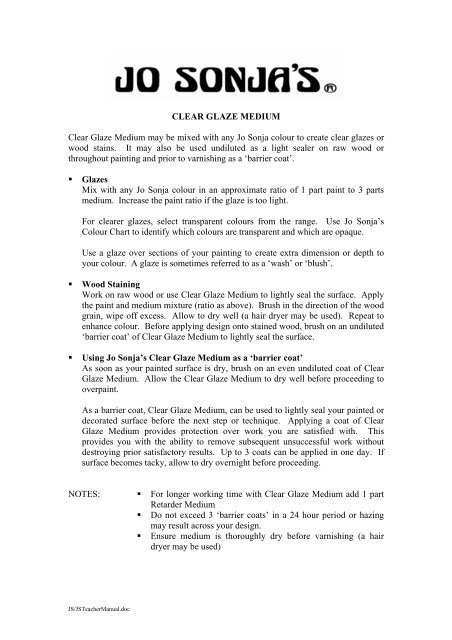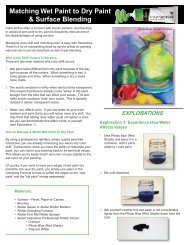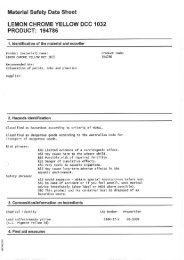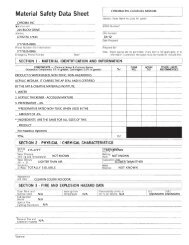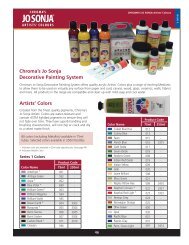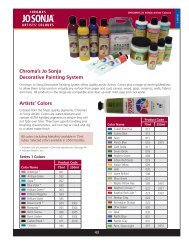Clear Glaze Medium - Chroma
Clear Glaze Medium - Chroma
Clear Glaze Medium - Chroma
Create successful ePaper yourself
Turn your PDF publications into a flip-book with our unique Google optimized e-Paper software.
CLEAR GLAZE MEDIUM<br />
<strong>Clear</strong> <strong>Glaze</strong> <strong>Medium</strong> may be mixed with any Jo Sonja colour to create clear glazes or<br />
wood stains. It may also be used undiluted as a light sealer on raw wood or<br />
throughout painting and prior to varnishing as a ‘barrier coat’.<br />
� <strong>Glaze</strong>s<br />
Mix with any Jo Sonja colour in an approximate ratio of 1 part paint to 3 parts<br />
medium. Increase the paint ratio if the glaze is too light.<br />
For clearer glazes, select transparent colours from the range. Use Jo Sonja’s<br />
Colour Chart to identify which colours are transparent and which are opaque.<br />
Use a glaze over sections of your painting to create extra dimension or depth to<br />
your colour. A glaze is sometimes referred to as a ‘wash’ or ‘blush’.<br />
� Wood Staining<br />
Work on raw wood or use <strong>Clear</strong> <strong>Glaze</strong> <strong>Medium</strong> to lightly seal the surface. Apply<br />
the paint and medium mixture (ratio as above). Brush in the direction of the wood<br />
grain, wipe off excess. Allow to dry well (a hair dryer may be used). Repeat to<br />
enhance colour. Before applying design onto stained wood, brush on an undiluted<br />
‘barrier coat’ of <strong>Clear</strong> <strong>Glaze</strong> <strong>Medium</strong> to lightly seal the surface.<br />
� Using Jo Sonja’s <strong>Clear</strong> <strong>Glaze</strong> <strong>Medium</strong> as a ‘barrier coat’<br />
As soon as your painted surface is dry, brush on an even undiluted coat of <strong>Clear</strong><br />
<strong>Glaze</strong> <strong>Medium</strong>. Allow the <strong>Clear</strong> <strong>Glaze</strong> <strong>Medium</strong> to dry well before proceeding to<br />
overpaint.<br />
As a barrier coat, <strong>Clear</strong> <strong>Glaze</strong> <strong>Medium</strong>, can be used to lightly seal your painted or<br />
decorated surface before the next step or technique. Applying a coat of <strong>Clear</strong><br />
<strong>Glaze</strong> <strong>Medium</strong> provides protection over work you are satisfied with. This<br />
provides you with the ability to remove subsequent unsuccessful work without<br />
destroying prior satisfactory results. Up to 3 coats can be applied in one day. If<br />
surface becomes tacky, allow to dry overnight before proceeding.<br />
NOTES: � For longer working time with <strong>Clear</strong> <strong>Glaze</strong> <strong>Medium</strong> add 1 part<br />
Retarder <strong>Medium</strong><br />
� Do not exceed 3 ‘barrier coats’ in a 24 hour period or hazing<br />
may result across your design.<br />
� Ensure medium is thoroughly dry before varnishing (a hair<br />
dryer may be used)<br />
JS/JSTeacherManual.doc
FLOW MEDIUM<br />
� Jo Sonja’s Flow <strong>Medium</strong> is used to thin paints and other mediums. Water may<br />
dilute paint’s acrylic binder, reducing the adhesive qualities. When Flow <strong>Medium</strong><br />
is added in small amounts, it produces a thinner, smoother paint which leaves no<br />
brush marks. Paint mixed with Flow <strong>Medium</strong> will deliver a remarkably long<br />
stroke with very fine detail and definition.<br />
� DIRECTIONS<br />
1. Mix into desired colour using brush or palette knife starting at a ratio of 2 parts<br />
paint to 1 part Flow <strong>Medium</strong>.<br />
2. Make sure Flow <strong>Medium</strong> is evenly dispersed before applying paints. Use this<br />
combination for all techniques requiring a smooth finish, such as basecoating.<br />
Addition of Flow <strong>Medium</strong> to the paint will increase the drying time.<br />
3. Decorate as desired<br />
Airbrushing<br />
Use Jo Sonja’s Flow <strong>Medium</strong> instead of water to reduce the viscosity of Jo Sonja<br />
Artists Colours. Most airbrush artists use 3 parts Flow <strong>Medium</strong> to 1 part paint. This<br />
will vary with your style and equipment.<br />
Troubleshooting<br />
Reaction with varnish Allow adequate drying time before applying varnish.<br />
Flow <strong>Medium</strong> may take 3-5 days to dry depending on<br />
climatic conditions. A hair dryer will speed the<br />
process.<br />
JS/JSTeacherManual.doc
DÉCOR CRACKLE MEDIUM<br />
Décor Crackel is a transparent medium to be used BETWEEN layers of Jo Sonja’s<br />
Artists’ Colours to provide a weathered paint or aged appearance.<br />
The top colour will break apart to reveal the base colour. Metallic and Iridescent<br />
colours should not be used over Décor Crackle as they will not work effectively.<br />
They may however be used as base coat colours.<br />
Pre-test varnish over Decor Crackle as some water based varnishes can reactivate this<br />
medium. Solvent varnishes may be used over.<br />
DIRECTIONS<br />
� Seal the surface with All Purpose Sealer or mix Sealer with your base colour.<br />
You may use tube or Background Colours.<br />
� When dry, apply an even medium to thick coat of Décor Crackle <strong>Medium</strong>.<br />
� Allow the Décor Crackle to completely dry, a hair dryer may be used.<br />
� Apply a contrasting coat of Jo Sonja’s Artists’ Colours. This top colour will<br />
separate to expose the base colour. Wide cracks will result from a heavier<br />
application of paint, finer from a thinner application.<br />
� The crackle effect will appear slowly as the top coat dries.<br />
NOTES: � Jo Sonja’s Décor Crackle is formulated to work with Jo Sonja’s<br />
Artists’ Colours. If using an alternate brand, particularly as the<br />
top coat, we suggest pre-testing to ensure compatibility<br />
� Jo Sonja’s tube colours generally give a better result than Jo<br />
Sonja’s Background Colours. House paints in most cases are not<br />
compatible.<br />
� Once crackled and dry, if not sealed or varnished, water can<br />
reactivate Décor Crackle and cause it to blister and peel. If you<br />
wish to crackle a background and paint a design directly over it,<br />
we recommend a coat of <strong>Clear</strong> <strong>Glaze</strong> <strong>Medium</strong> to lightly seal<br />
before proceeding. Be light and quick when applying your<br />
medium or varnish and do not over-work.<br />
� The pattern of the crackle can be altered depending on how you<br />
apply your top coat colour. If you brush straight up and down, a<br />
fairly straight pattern will result. Try cross hatching, even a<br />
circular motion to achieve different effects. Applying your top<br />
coat colour with a lightly damp sea sponge looks different again.<br />
JS/JSTeacherManual.doc
CRACKLE MEDIUM<br />
Jo Sonja’s Crackle <strong>Medium</strong> is a transparent medium used to create fine, crackle<br />
effected over completed acrylic paintings. This medium dries clear and will produce<br />
a ‘cracked varnish’ effect like that found on old porcelain. Once dry, this medium is<br />
intended to be sanded smooth and antiqued to highlight crazed areas.<br />
Directions<br />
� Prepare piece and paint in the usual manner. Allow to dry.<br />
� Using a soft brush, apply an even layer of Jo Sonja’s Porcelain Crackle over the<br />
surface where the crazing effect is desired. The brush should be used similar to a<br />
palette knife, laying on the medium instead of ‘brushing’ it out. After it is applied<br />
to the surface, overbrushing or reworking produces very fine, wispy crackles.<br />
� Crackling will occur if room temperature is moderate to warm. Do not touch<br />
during the drying process. If surface is uneven when dry, lightly sand.<br />
� <strong>Medium</strong> will be cured when completely dry. To emphasize the crazing, brush a<br />
darker colour thinned with either Jo Sonja’s Flow <strong>Medium</strong> or Jo Sonja’s Retarder<br />
into the cracks. Use a soft cloth moistened with Retarder to remove excess colour.<br />
� Practice on a sample piece is recommended before attempting a project.<br />
� NOTE: Thicker applications of Jo Sonja’s Crackle over fresher paint will create<br />
larger crackle patterns.<br />
Troubleshooting<br />
Cracking is not evident: Possibly not enough medium applied or overworking of<br />
the medium.<br />
‘Spread’ rather than brush across the surface, apply a<br />
generous amount.<br />
A good test is to pour some Crackle <strong>Medium</strong> directly<br />
onto your palette. Allow this to thoroughly dry. If the<br />
<strong>Medium</strong> has cracked then the product is not being<br />
Crackle <strong>Medium</strong> dries<br />
unevenly<br />
JS/JSTeacherManual.doc<br />
applied thickly enough on your piece.<br />
Sand smooth when thoroughly dry and antique to<br />
highlight cracks.<br />
Uneven size of actual cracks is normal. If a more<br />
consistent result is desired, try to apply the medium<br />
more evenly. A ruler is useful for spreading.
POLYURETHANE VARNISHES<br />
Polyurethane provides the toughest finish available. The two types of finishes<br />
available are Satin and Gloss. Both varnishes have excellent brushing qualities. Use<br />
indoors or outdoors to provide maximum, long term protection. Both varnishes dry<br />
clear and are non-yellowing. They have excellent corrosion, chemical, scratch and<br />
wear resistance.<br />
Directions for Satin and Gloss Varnish<br />
1. Gently shake before use to ensure complete suspension of ingredients.<br />
2. Apply varnish using a large, soft bristled varnish brush with a gentle criss cross<br />
motion. Apply thin coats, covering a small section at a time. Smooth out the<br />
strokes by brushing in the same direction as the wood grain.<br />
***Several thin coats are better than one thick coat.<br />
3. Allow at least 1 hour between coats, as there will be less “drag” on the brush. Do<br />
not exceed 4 coats per day. NOTE: A slight milky appearance may occur when<br />
applying Jo Sonja’s Satin Varnish. This is normal and is more obvious on dark<br />
backgrounds. The milkiness should disappear as the varnish dries and cures.<br />
Sand lightly if 24 hours lapse between coats to ensure good adhesion. Apply at<br />
least 4 coats for maximum protection.<br />
4. As with most water based finishes, you can handle painted objects when they are<br />
dry to the touch, but maximum durability is not achieved until varnish reaches its<br />
cure time (at least 2 weeks under normal conditions).<br />
JS/JSTeacherManual.doc
TEXTURE PASTE<br />
� A white paste used for exaggerated structure and texture, to create 3-D effects.<br />
Dries to a very hard matt finish and may be either overpainted or mixed with Jo<br />
Sonja’s Artists’ Colours before application to produce a coloured, textured<br />
ground. Great for stencilling techniques and to adhere materials for mosaic and<br />
collage projects.<br />
Open grained wood such as oak may be filled using a mixture of Texture Paste<br />
and desired colour mixed 1:1. Apply this mix with a spatula and carefully remove<br />
any excess as you proceed across the surface. Let dry, then sand to a desired<br />
smoothness. Proceed to glaze with desired colour.<br />
DIRECTIONS<br />
1. Apply with a rubber spatula, palette knife, coarse brush or graining tool for<br />
textured background effects.<br />
2. Mix with paints to produce coloured grounds.<br />
3. Paintable as soon as dry. (At least 24 hours).<br />
4. Antiquing will emphasize textural effects.<br />
5. May be applied with a palette knife through a thick plastic stencil to create 3-D<br />
effects. A cake decorating bag with tips can also be used for dimensional effects.<br />
6. May be used to imbed objects such as shells, buttons and broken glass for<br />
mosaics, picture frames, walls, etc.<br />
JS/JSTeacherManual.doc
TEXTILE MEDIUM<br />
� A water based acrylic medium used to convert Jo Sonja’s Artists’ Colours into<br />
fabric paints, which become permanent when dried and heat set.<br />
� This finish can be washed and dry cleaned and should be applied to natural, nonsynthetic<br />
fibres. Textile <strong>Medium</strong> is only necessary if the fabric is to be laundered<br />
or dry cleaned.<br />
� Prewash all fabric, prior to painting to remove sizing from fabric fibres. A<br />
50% cotton content is recommended for best adhesion.<br />
DIRECTIONS<br />
1. Mix equal parts (1:1) of Textile <strong>Medium</strong> and Jo Sonja’s Artists’ Colours.<br />
2. Water may be used to thin the mixture. Use caution as water dilution may cause<br />
colour to bleed.<br />
3. To apply glitter on fabric, use All Purpose Sealer or Textile <strong>Medium</strong>. Experiment<br />
to see which one gives you the effect you desire.<br />
4. Use All Purpose Sealer on the edges of your cut fabric to prevent fraying. Seal ¼”<br />
beyond cut edges.<br />
5. The finished product MUST HE HEAT SET TO BECOME WASHER AND<br />
DRYER SAFE. Launder using mild detergent & delicate heat settings.<br />
� HEAT SET DIRECTIONS<br />
(a) Ovens: Preheat oven to 250 degrees F. Place aluminum foil in your oven to<br />
protect article from grease. Place article in oven for 1½ minutes. Remove and let<br />
cool. If you wrap the article in foil, allow 4-5 minutes in the oven for the heat to<br />
permeate the foil.<br />
(b) Irons: You’ll need to experiment to discover the proper heat setting for your<br />
iron. Prepare a small sample strip using similar material and apply your colours.<br />
Start your iron at the polyester setting and iron the sample strip. Keep increasing<br />
the temperature until you reach the point where your sample colours begin to<br />
change or shift. Once you know this limit, back off slightly and mark your<br />
setting. Use this for future heat setting on similar fabric.<br />
***Heat setting by tumble dryer is not recommended.<br />
JS/JSTeacherManual.doc
KLEISTER “FAUX FINISH” MEDIUM<br />
� ‘Kleister’ is an ‘old country’ term for faux finish techniques. A semi-transparent<br />
paste which, when added to paint, gives extra body for textural patterns, such as<br />
faux wood graining, marbling, tortoiseshell, etc. Kleister may also be used as a<br />
painting medium.<br />
Uses for Kleister <strong>Medium</strong><br />
1. Use for all traditional Kleister or faux woodgraining techniques. A simple<br />
technique using a woodgraining tool to simulate natural wood is to mix a “grain”<br />
colour into Kleister <strong>Medium</strong> approximately 1:3. You may wish to add Jo Sonja’s<br />
Retarder to further extend the working time.<br />
2. Use for stroke work where transparency and texture is desired. A small amount of<br />
Jo Sonja’s Texture Paste may be mixed into the Kleister <strong>Medium</strong> (1:1) to increase<br />
the textural properties.<br />
3. Use as a general painting medium to facilitate long stroke work techniques, stripes<br />
of different colours, etc.<br />
� Preparing a smoked background for painting techniques<br />
(a) Paint background desired colour plus All Purpose Sealer (1:1)<br />
(b) Let dry, then lightly sand. Remove all sanding dust.<br />
(c) Give object a barrier coat of Jo Sonja’s <strong>Clear</strong> <strong>Glaze</strong> <strong>Medium</strong>.<br />
(d) Brush on one thick coat of Kleister <strong>Medium</strong>. Hold over open candle flame.<br />
Using the edge of a metal palette knife or spoon, touch the flame to produce sooty<br />
smoke. Work quickly as the heat will dry out the Kleister <strong>Medium</strong>. The Kleister<br />
<strong>Medium</strong> will hold the soot residue in place. Allow to dry completely.<br />
(e) Carefully apply a barrier coat of Jo Sonja’s <strong>Clear</strong> <strong>Glaze</strong> <strong>Medium</strong> to protect<br />
smoked area.<br />
JS/JSTeacherManual.doc
STROKE & BLENDING MEDIUM<br />
� Stroke and Blending <strong>Medium</strong> is a medium formulated for ease in stroke blending<br />
and floated colour techniques. This medium will slow the drying time of paint to<br />
allow blending of paint wet in wet or wet over dry. It is heavier bodied than Jo<br />
Sonja’s Retarder and Antiquing <strong>Medium</strong> and strokes will not bleed out.<br />
� To use for floating, dress Stroke & Blending <strong>Medium</strong> into your brush instead of<br />
water. It will ease blending and allow a longer open time. A drop on your palette<br />
paper will remain moist all day!<br />
� Add Stroke & Blending <strong>Medium</strong> to paint anytime paint feels too “tight” to make it<br />
spread more easily. Excellent for strokework. Jo Sonja’s Flow <strong>Medium</strong> can be<br />
added to decrease the viscosity of paint.<br />
� For wet over dry blending use Stroke and Blending <strong>Medium</strong> to soften dry brush<br />
edges, blending fresh paint with the dry layer beneath.<br />
� For a softer oil-like look to your stencilling, dress the stencil brush in a small<br />
amount of Stroke and Blending <strong>Medium</strong> before picking up your colour and<br />
applying through stencil.<br />
� For a brush or rub-on stain, mix the stain colour of your choice with Stroke and<br />
Blending <strong>Medium</strong> until the desired amount of colour is achieved. Apply to wood<br />
with a soft lint-free cloth or sponge.<br />
� Surfaces painted using Stroke & Blending <strong>Medium</strong> must be completely dry (at<br />
least 24 hrs) before proceeding to varnish. Allow longer if weather is cool, damp<br />
or if plenty of <strong>Medium</strong> has been used. A hair dryer will speed the process.<br />
JS/JSTeacherManual.doc
RETARDER AND ANTIQUING MEDIUM<br />
� Retarder and Antiquing <strong>Medium</strong> is an additive to extend the “open” or drying time<br />
of Jo Sonja’s Colours and <strong>Medium</strong>s. Acrylic paints dry rapidly in conditions of<br />
low humidity and/or high temperature. Both air conditioning and winder heating<br />
reduce the levels of humidity in a room causing acrylic paints to dry faster.<br />
DIRECTIONS<br />
1. Add Retarder to your paint by dipping your brush into it as you paint, or apply<br />
over the entire surface area for wet on wet techniques. Blend with a mop brush to<br />
ensure an even coat without puddles.<br />
2. Retarder may be mixed directly into your paints.<br />
3. When used for antiquing, dilute your colours with Retarder instead of water for a<br />
longer open time. Earth colours are popular for antiquing.<br />
Important: Paints containing Retarder may appear to be dry but can be reactivated.<br />
They can take up to 5 days to cure unless force dried with warm air. When<br />
proceeding with additional steps or varnishing a piece, care should be taken that all<br />
Retarder is completely dry.<br />
Note: CRACKLE MEDIUM WILL NOT ADHERE TO A SURFACE<br />
CONTAINING ANY TRACES OF UNCURED RETARDER THAT IS NOT<br />
COMPLETELY DRY.<br />
JS/JSTeacherManual.doc
GLASS & TILE PAINTING SYSTEM<br />
Consisting of Glass & Tile Primer (Part A) and Glass & Tile Painting <strong>Medium</strong> (Part<br />
B), this system adapts Jo Sonja’s Artists’ Colours to durable, decorative glass and<br />
ceramic paints. When used together (Part A and Part B), designs are air drying – no<br />
need for oven curing.<br />
DIRECTIONS<br />
1. Apply Glass & Tile Primer (Part A) to clean, dry glass or ceramic surfaces where<br />
you intend to paint the design. This Primer may be applied all over the surface if<br />
you are unsure of design area.<br />
A ‘blooming’ or cloudiness may be evident on Glass. This can be buffed off after<br />
designs have cured. Do not use this product on plastic, as it is not intended for<br />
this application. It is purely a bonding agent between glass and paint.<br />
2. Mix your chosen Jo Sonja Colours with Glass & Tile <strong>Medium</strong> (Part B) in a ration<br />
of approximately one part paint to 2-3 parts <strong>Medium</strong>. (The more <strong>Medium</strong> used,<br />
the more durable the design). Allow the mixture to sit for a few minutes before<br />
painting your design.<br />
***NOTE: Some artists apply an undiluted coat of Glass & Tile <strong>Medium</strong> (Part B) to<br />
area to be painted to increase durability. This is optional. Glass & Tile <strong>Medium</strong><br />
should still be mixed into your paints as above.<br />
3. Paint designs as desired. If design is too transparent, allow each layer to<br />
thoroughly dry before painting over. When complete, varnish if desired (2-3 coats<br />
of Jo Sonja’s Polyurethane Satin or Gloss Varnish). Allow items to sit for 2<br />
weeks before use. The item may then be washed with care in warm soapy water.<br />
Notes<br />
� Abrasive cleaning agents may remove parts of the design. Use care when<br />
cleaning.<br />
� Tiling grout should not be rubbed across designs.<br />
� Do not soak items in very hot water<br />
� Dishwashers should be avoided<br />
� Do not use on areas where scraping will remove design, eg plate centres.<br />
JS/JSTeacherManual.doc<br />
Do not use Cadmium Colours on food related items.
JO SONJA’S WOOD FILLER<br />
Water-based, non-toxic and fast drying, this easy to use filler is ideal for nail holes<br />
and blemishes in wood and MDF.<br />
Use directly from the tub or thin with up to 10% water to repair minor imperfections<br />
or fill grain. May be tinted using Jo Sonja’s Artists’ Colours or painted over when dry<br />
and sanded. May also be used to repair damage to painted items, pre-tint or overpaint<br />
as necessary.<br />
Directions<br />
� Apply using a plastic palette knife and smooth lightly. Filler will dry in minutes<br />
when used in thin layers. Sand lightly before proceeding to paint your item.<br />
� If staining a timber piece with Jo Sonja’s <strong>Clear</strong> <strong>Glaze</strong> <strong>Medium</strong> or Jo Sonja’s<br />
Wood Stain <strong>Glaze</strong>s, prepare item with Jo Sonja’s Wood Filler prior to staining.<br />
The filler will accept the stain perfectly and will not be clearly visible.<br />
Trouble Shooting<br />
Hardening of contents: Stand pot in hot water until soft, or add a<br />
few drops of water to smooth<br />
Reactivating when overpainting: If you apply a very watery wash over the<br />
Filler, it ‘may’ reactivate. Allow 12-24<br />
hours to harden if this is the case, or<br />
apply a coat of Jo Sonja’s <strong>Clear</strong> <strong>Glaze</strong><br />
<strong>Medium</strong> to lightly seal before proceeding<br />
with wash.<br />
Colour incorrect for repairs or touch ups: Tint with Jo Sonja Colours and apply<br />
smoothly. Dry overnight and touch up<br />
with varnish.<br />
‘Greying’ of Filler on application: Do not use a metal spatula for<br />
application. Use wood or plastic.<br />
JS/JSTeacherManual.doc
GESSO<br />
“Grounds” are products used to prepare a surface for acrylic and/or oil painting.<br />
Good preparation will not only ensure good paint adhesion, but will prove more<br />
economical as less paint will be absorbed into the surface. Although acrylics can be<br />
applied directly to a surface without first applying a ground, the acrylic binder from<br />
the paint is absorbed too quickly into the surface being worked on. The result is a<br />
drab and disappointing painting, with a disagreeably fast drying speed. Acrylic<br />
grounds are recommended before painting.<br />
Jo Sonja’s Gesso is a flexible acrylic ground with a high grit content which provides<br />
“tooth” on which to paint. It is not water absorbent and does not suck the moisture<br />
out of your paint when you start to work on it.<br />
Available in black and white, Jo Sonja’s Gesso may be used instead of, or as well as,<br />
All Purpose Sealer. Usually applied on very porous or uneven surfaces, the grit will<br />
have a slight levelling effect, which is beneficial for inferior surfaces or rough edges.<br />
NB: For deep grain or blemishes we recommend Jo Sonja’s Wood Filler for<br />
levelling.<br />
Directions<br />
� Apply to clean, dry surface; allow to dry before proceeding with more coats. A<br />
hair dryer may be used. Apply as many coats as required.<br />
� May be sanded between coats if desired. Sanding is recommended prior to<br />
painting over to provide smooth surface. Use dry sanding method, not wet.<br />
Notes<br />
� White Gesso may be tinted with regular Jo Sonja’s Artists’ Colours to create a<br />
‘pastel primer’.<br />
� Black Gesso makes an excellent blackboard paint. A light sanding is<br />
recommended to smooth the surface for chalk.<br />
� Gesso is excellent to apply prior to base coating with a transparent colour, ie ‘Raw<br />
Sienna’. The white or black colour will add ‘opacity’ to the subsequent coats of<br />
paint. The result will be a brighter, more solid base coat.<br />
� White Gesso may be thinned with water or <strong>Clear</strong> <strong>Glaze</strong> <strong>Medium</strong> and applied as a<br />
wood wash or liming glaze. The more Gesso in the mix, the ‘chalkier’ the effect.<br />
Trouble Shooting<br />
Brown stain penetrating through White<br />
Gesso’d surface:<br />
Use Tannin Sealer x 2/3 coats one week<br />
prior to applying Gesso. Old furniture can<br />
often ‘stain’ through an acrylic base coat<br />
– particularly light colours.<br />
Gesso thickening in jar: Thin with water at time of application, or<br />
use Flow <strong>Medium</strong>. Do not add medium<br />
or water directly to the jar.<br />
Surface difficult to sand: Use a stronger grade of paper; automotive<br />
emery papers are often excellent for this<br />
application.<br />
JS/JSTeacherManual.doc
BACKGROUND COLOURS<br />
Jo Sonja’s Background Colours are specially formulated for easy one coat<br />
backgrounding and are intended for all decorative and fine art applications. Use<br />
straight from the jar as a background colour, or combine with other Jo Sonja’s<br />
Colours to create different shades.<br />
Beautifully ‘toned’, Jo Sonja’s Background Colours will not clash with your designs<br />
but will beautifully enhance them. The selection of Background Colours has been<br />
carefully chosen to combine with endless palette choices, making them very versatile<br />
and economical.<br />
Smooth, rich and creamy, often one coat is all you will need. Prior sealing on porous<br />
surfaces with Gesso or All Purpose Sealer is recommended to prevent the paint<br />
soaking in. Alternatively All Purpose Sealer may be mixed in equal proportions for<br />
one-step base coating.<br />
Only the finest quality pigments are used to create Jo Sonja’s Background Colours so<br />
you can be assured of lightfastness in all conditions.<br />
Notes<br />
� Background Colours may also be used for stroke work<br />
� Pastel artists enjoy priming their boards with these colours, as do coloured pencil<br />
artists<br />
� Suitable for fine art works on canvas, regular acrylics or oils may be applied over<br />
Jo Sonja’s Background Colours<br />
Trouble Shooting<br />
Background Colours become thick in jar: Add a small amount of water or Jo<br />
Sonja’s Flow <strong>Medium</strong> to thin at time of<br />
application. Do not add these directly to<br />
the jar. Decant and thin as necessary<br />
Background Colours are not as effective<br />
over Décor Crackle <strong>Medium</strong> as regular Jo<br />
Sonja’s tube colours. They may be used<br />
successfully as a base coat however.<br />
JS/JSTeacherManual.doc
TANNIN SEALER & GOLD LEAF SIZE<br />
Tannin Sealer is recommended to prepare surfaces for painting which are likely to<br />
‘stain through’ paint layers.<br />
These may include knotted wood, old lacquered or stripped furniture and masonite.<br />
Tannin Sealer may also be used as a Gold Leaf Size and may be used with real and<br />
imitation leaf.<br />
Directions<br />
� Wood knots: apply undiluted to clean, dry surface, directly over and at least 2”<br />
beyond knots. Do not use a hair dryer to dry, as this will encourage pitch or<br />
staining to rise through the wood. Apply at least 2 coats.<br />
� Allow to cure for 7 days before proceeding to paint or decorate.<br />
� When staining wood, stain first, then apply Tannin Sealer as above.<br />
� Tannin Sealer dries tacky when cured. This is normal and may be painted over<br />
without problem.<br />
Gold Leafing<br />
� Brush on smooth, even coat of Tannin Sealer and allow to dry. Apply one<br />
additional coat and allow to dry naturally until no fingerprint is left when touched.<br />
� Press gold leaf onto this surface; heat gently with a hair dryer before removing the<br />
excess.<br />
� If you are working on a larger item or require longer working time, add a small<br />
amount of Jo Sonja’s Retarder <strong>Medium</strong> as required.<br />
� When gold leafing is complete, apply Jo Sonja’s All Purpose Sealer or Varnish to<br />
prevent tarnishing.<br />
� Wash hands and brushes in water<br />
Notes: Tanning Sealer may be used for pre-sealing items if<br />
you have run out of All Purpose Sealer. It may be<br />
used the same way.<br />
Tannin Sealer should not be applied over oily<br />
stains. Adhesion will be poor and oil may still<br />
penetrate the Sealer.<br />
Trouble Shooting: � Wood knots: Stains still penetrating through<br />
paint layers. Apply 2-3 coats more of Tannin<br />
Sealer; allow 7 days to harden before<br />
proceeding.<br />
� Gold Leafing: Sealer dries before leaf is<br />
applied. Mix a few drops of Retarder <strong>Medium</strong><br />
with Tannin Sealer and apply over. When<br />
tacky, apply leaf.<br />
� Gold leaf becomes dull on application. Possibly<br />
the Tannin Sealer was too wet. Allow long<br />
drying time before application.<br />
JS/JSTeacherManual.doc
ALL PURPOSE SEALER<br />
All Purpose Sealer is a surface ‘primer’ and will seal a wide variety of items in<br />
preparation for painting.<br />
Pre-priming with All Purpose Sealer or Gesso will ensure good paint adhesion and<br />
will prevent moisture loss into absorbent surfaces.<br />
Use All Purpose Sealer rather than Gesso on items which require sealing without<br />
‘tooth’ or opaque colour.<br />
Suitable items for sealing include: wood, MDF (Fibreboard), cardboard, paper,<br />
canvas, metal, unglazed bisque and terracotta. Test for suitable adhesion on unusual<br />
surfaces. All Purpose Sealer will assist adhesion to some plastics, soaps and wide<br />
candles where flames will not come in contact with the design. A light sanding is<br />
recommended to promote adhesion of paint to any of these surfaces.<br />
Directions<br />
� Apply undiluted to clean, dry surface. When dry, lightly sand before painting.<br />
� Alternatively, mix and apply paint and Sealer in equal proportions. Sand when<br />
dry and apply a second coat of paint without Sealer added.<br />
� Metal or tin should be clean, rust free and lightly sanded. Apply Sealer undiluted;<br />
allow 24 hours to harden before painting. (This product will not inhibit rust). A<br />
hair dryer may be used to speed drying.<br />
� Wash hands and brushes in water<br />
Notes: All Purpose Sealer makes an excellent glue to<br />
adhere decoupage gift wrap or fabric to wood and<br />
other items previously listed<br />
All Purpose Sealer is a primer, not a finishing<br />
varnish. When used as a varnish it may become<br />
tacky in warm weather and cause surfaces to stick<br />
together. It is also not as durable as Jo Sonja’s<br />
Polyurethane Varnish.<br />
Trouble Shooting: � Paint dries too fast when Sealer is added:<br />
adding All Purpose Sealer directly to your<br />
paints causes them to dry more rapidly. Prevent<br />
this by either pre-sealing with All Purpose<br />
Sealer and then over painting or add a few drops<br />
of Retarder <strong>Medium</strong> or Flow <strong>Medium</strong> to slow<br />
the drying time.<br />
� Brushes become stiff when using All Purpose<br />
Sealer: Ensure brushes are rinsed often during<br />
the painting process. Wash well after painting<br />
in cool water; soap may be used.<br />
JS/JSTeacherManual.doc
JO SONJA’S WOOD FILLER<br />
Water-based, non-toxic and fast drying, this easy to use filler is ideal for nail holes<br />
and blemishes in wood and MDF.<br />
You will be delighted at how much more professional your pieces can be. This filler<br />
can even be used after you have finished painting, to repair minor damage.<br />
Directions<br />
� Apply using a plastic palette knife and smooth lightly. Filler will dry in minutes<br />
when used in thin layers. Sand lightly before proceeding to paint your item.<br />
� If staining a timber piece with Jo Sonja’s <strong>Clear</strong> <strong>Glaze</strong> <strong>Medium</strong> or Jo Sonja’s<br />
Wood Stain <strong>Glaze</strong>s, prepare item with Jo Sonja’s Wood Filler prior to staining.<br />
The filler will accept the stain perfectly and will not be clearly visible.<br />
Jo Sonja’s Artists’ Colours may also be used to ‘lightly tint’ this filler and a small<br />
amount of water (up to 10%) may be added for filling grain.<br />
Trouble Shooting<br />
Hardening of contents: Stand pot in hot water until soft, or add a<br />
few drops of water to smooth<br />
Reactivating when overpainting: It you apply a very watery wash over the<br />
Filler, it ‘may’ reactivate. Allow 12-24<br />
hours to harden if this is the case, or<br />
apply a coat of Jo Sonja’s <strong>Clear</strong> <strong>Glaze</strong><br />
<strong>Medium</strong> to lightly seal before proceeding<br />
with wash.<br />
Colour incorrect for repairs or touch ups: Tint with Jo Sonja Colours and apply<br />
smoothly. Dry overnight and touch up<br />
with varnish.<br />
‘Greying’ of Filler on application: Do not use a metal spatula for<br />
application. Use wood or plastic.<br />
JS/JSTeacherManual.doc
GESSO<br />
“Grounds” are products used to prepare a surface for acrylic and/or oil painting.<br />
Good preparation will not only ensure good paint adhesion, but will prove more<br />
economical as less paint will be absorbed into the surface. Although acrylics can be<br />
applied directly to a surface without first applying a ground, the acrylic binder from<br />
the paint is absorbed too quickly into the surface being worked on. The result is a<br />
drab and disappointing painting, with a disagreeably fast drying speed. Acrylic<br />
grounds are recommended before painting.<br />
Jo Sonja’s Gesso is a flexible acrylic ground with a high grit content which provides<br />
“tooth” on which to paint. It is not water absorbent and does not suck the moisture<br />
out of your paint when you start to work on it.<br />
Available in black and white, Jo Sonja’s Gesso may be used instead of, or as well as,<br />
All Purpose Sealer. Usually applied on very porous or uneven surfaces, the grit will<br />
have a slight levelling effect, which is beneficial for inferior surfaces or rough edges.<br />
NB: For very deep grain or blemishes we recommend Jo Sonja’s Wood Filler for<br />
levelling.<br />
Directions<br />
� Apply to clean, dry surface; allow to dry before proceeding with more coats. A<br />
hair dryer may be used. Apply as many coats as required.<br />
� May be sanded between coats if desired. Sanding is recommended prior to<br />
painting over to provide smooth surface. Use dry sanding method, not wet.<br />
Notes<br />
� White Gesso may be tinted with regular Jo Sonja’s Artists’ Colours to create a<br />
‘pastel primer’.<br />
� Black Gesso makes an excellent blackboard paint. A light sanding is<br />
recommended to smooth the surface for chalk.<br />
� Gesso is excellent to apply prior to base coating with a transparent colour, ie ‘Raw<br />
Sienna’. The white or black colour will add ‘opacity’ to the subsequent coats of<br />
paint. The result will be a brighter, more solid base coat.<br />
� White Gesso may be thinned with water or <strong>Clear</strong> <strong>Glaze</strong> <strong>Medium</strong> and applied as a<br />
wood wash or liming glaze. The more Gesso in the mix, the ‘chalkier’ the effect.<br />
Trouble Shooting<br />
Brown stain penetrating through White<br />
Gesso’d surface:<br />
Use Tannin Sealer x 2/3 coats one week<br />
prior to applying Gesso. Old furniture can<br />
often ‘stain’ through an acrylic base coat<br />
– particularly light colours.<br />
Gesso thickening in jar: Thin with water at time of application, or<br />
use Flow <strong>Medium</strong>. Do not add medium<br />
or water directly to the jar.<br />
Surface difficult to sand: Use a stronger grade of paper; automotive<br />
emery papers are often excellent for this<br />
application.<br />
JS/JSTeacherManual.doc


